Umpire (baseball)
In baseball, the umpire is the person charged with officiating the game, including beginning and ending the game, enforcing the rules of the game and the grounds, making judgment calls on plays, and handling the disciplinary actions.[1] The term is often shortened to the colloquial form ump. They are also sometimes addressed as blue at lower levels due to the common color of the uniform worn by umpires. In professional baseball, the term blue is seldom used by players or managers, who instead call the umpire by name. Although games were often officiated by a sole umpire in the formative years of the sport, since the turn of the 20th century, officiating has been commonly divided among several umpires, who form the umpiring crew. The position is analogous to that of a referee in many other sports.
%2C_Cleveland_coach%2C_umpire_Adam_Hamari_(78)_%2C_umpire_Kerwin_Danley%2C_umpire_Ryan_Blakney.jpg)
Duties and positions
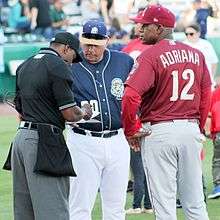
In a game officiated by two or more umpires, the umpire in chief (usually the home plate umpire) is the umpire who is in charge of the entire game. This umpire calls balls and strikes, calls fair balls, foul balls short of first/third base, and makes most calls concerning the batter or concerning baserunners near home plate. To avoid injury, the home plate umpire wears similar equipment to the catcher, including mask, chest protector, leg guards and shoes with extra protection added over the laces.[1] If another umpire leaves the infield to cover a potential play in foul ground or in the outfield, then the plate umpire may move to cover a potential play near second or third base. (The umpire-in-chief should not be confused with the crew chief, who is often a different umpire; see below.) In the event that an umpire is injured and only three remain, the second base position will generally be left vacant.
In nearly all levels of organized baseball, including the majors, an umpiring crew rotates so that each umpire in the crew works each position, including plate umpire, an equal number of games. In the earliest days of baseball, however, many senior umpires always worked the plate, with Hall of Fame umpire Bill Klem being the last umpire to do so. Klem did so for the first 16 years of his career.[2] On the Major League level, an umpiring crew generally rotates positions clockwise each game. For example, the plate umpire in one game would umpire third base in the next.
Other umpires are called base umpires and are commonly stationed near the bases. (Field umpire is a less-common term.) When two umpires are used, the second umpire is simply the base umpire. This umpire will make most calls concerning runners on the bases and nearby plays, as well as in the middle of the outfield. When three umpires are used, the second umpire is called the first-base umpire and the third umpire is called the third-base umpire, even though they may move to different positions on the field as the play demands.[1] These two umpires also call checked swings, if asked by the plate umpire (often requested by catcher or defensive manager; however, only the plate umpire can authorize an appeal to the base umpire): the first base umpire for right-handed batters, and the third base umpire for left-handed batters; to indicate a checked swing, the umpire will make a "safe" gesture with his arms. To indicate a full swing, he will clench his fist.
When four umpires are used (as is the case for all regular season MLB games unless one has to leave due to injury), each umpire is named for the base at which he is stationed. Sometimes a league will provide six umpires; the extra two are stationed along the outfield foul lines and are called the left-field and right-field umpires (or simply outfield umpires).
Outfield umpires are used in major events, such as the Major League Baseball All-Star Game, and depending on the level, at parts of post-season playoffs. For Major League Baseball, all playoff levels use six umpires adding a left-field and right-field umpire, while at lower levels, six umpires are used at the championship games (such as NCAA).[3] Rulings on catches of batted balls are usually made by the umpire closest to the play.
Crew chief
The term umpire-in-chief is not to be confused with the crew chief, who is usually the most experienced umpire in a crew. At the major-league and high minor-league (Class AAA and AA) levels, the crew chief acts as a liaison between the league office and the crew and has a supervisory role over other members of the crew.[4]
For example, on the Major League level, "The Crew Chief shall coordinate and direct his crew's compliance with the Office of the Commissioner's rules and policies. Other Crew Chief responsibilities include: leading periodic discussions and reviews of situations, plays and rules with his crew; generally directing the work of the other umpires on the crew, with particular emphasis on uniformity in dealing with unique situations; assigning responsibilities for maintaining time limits during the game; ensuring the timely filing of all required crew reports for incidents such as ejections, brawls and protested games; and reporting to the Office of Commissioner any irregularity in field conditions at any ballpark."[4] Thus, on the professional level, some of the duties assigned to the umpire-in-chief (the plate umpire) in the Official Baseball Rules have been reassigned to the crew chief, regardless of the crew chief's umpiring position during a specific game. Instant replay reviews, for example, will be reviewed with the crew chief and one other umpire, with results announced by the crew chief. The crew chief acts analogous to the crew chief in basketball (as referenced in the NBA and FIBA rules) or the referee in American football.
Judgment calls
An umpire's judgment call used to be final, unless the umpire making the call chose to ask his partner(s) for help and then decided to reverse it after the discussion.[1] Since 2014, the MLB allows managers to challenge plays during the game. If the manager successfully has a call overturned, they are rewarded with another challenge.[5] If an umpire seems to make an error in rule interpretation, his call, in some leagues, can be officially protested as is the case in MLB.[1] If the umpire is persistent in his or her interpretation, the matter will be settled at a later time by a league official. An independent study of umpire pitch-call accuracy over 11 seasons (2008-2018) released on April 8, 2019 by Mark T. Williams of Boston University concluded that over 20% of certain pitches were called incorrectly. For the 2018 season, home plate umpires made about 34,000 incorrect ball and strike calls, which is about 14 per game and 1.6 per inning.[6]
In the early years of professional baseball, umpires were not engaged by the league but rather by agreement between the team captains. However, by the start of the modern era in 1901, this had become a league responsibility. There is now a unitary major league umpiring roster, although until the 1999 labor dispute that led to the decertification of the Major League Umpires Association, there were separate National and American League umpires. As a result of the 2000 collective bargaining agreement between Major League Baseball and the newly formed World Umpires Association (now known as the Major League Baseball Umpires Association) all umpires were placed on one roster and work in games in both leagues.
Amateur umpiring
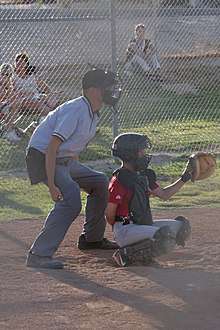
An amateur umpire officiates non-professional or semi-professional baseball. Many amateur umpires are paid (typically on a per-game basis) and thus might be considered professionals, while some amateur umpires are unpaid. According to the Little League Baseball official website, umpires should be volunteers.[7]
There are numerous organizations that test or train anyone interested in umpiring for local leagues, and can help make connections to the leagues in the area. Little League Baseball and the Babe Ruth League are two of the most popular organizations when it comes to youth baseball, and each have their own application, test, and training process for becoming an umpire. In Canada, most umpires are certified through a provincial organization, and then hired by local municipal associations through an umpire in chief.
For the Little League World Series, amateur umpires from around the world participate on a volunteer basis. Prospective Little League World Series umpires must participate at various levels of Little League All-Star tournaments, ranging from district to state to regional tournaments, prior to being accepted to work the World Series tournament.[8]
High school umpiring
In the United States, many (if not most) high schools sponsor a baseball team. Many high schools sponsor multiple baseball teams; for instance, "varsity" and "junior varsity" teams. During the 2017-18 academic year there were 16,513 high schools sponsoring at least one baseball team, and 488,859 students participated on a high school baseball team.[9] Thus, high school baseball is one of the most popular levels of baseball in the United States. Unlike college athletics, there is no competitive national championship on the high school level. And, unlike college athletics, umpires on the high school level are not administered by a national organization (such as the NCAA). Rather, high school baseball is administered at the state level (usually by a statewide high school athletic association) and the qualifications for becoming and remaining a high school umpire are usually set by the entity overseeing high school baseball in each individual state. For example, the Florida High School Athletic Association sets forth minimum requirements for being a high school umpire in Florida.[10] Many statewide high school athletic associations contract with multiple local umpire associations throughout their state in which the local associations agree to train and provide umpires for high school games in each association's geographic area of the state in return for a "booking fee" being paid to the local associations by either the statewide high school association or by individual high schools. The local associations also promise to train their umpires to meet the state high school association's minimum requirements for umpires. For example, in Florida the Jacksonville Umpires Association trains and provides umpires for high school games in the Jacksonville area.[11]
The specific requirements for becoming a high school umpire vary from state-to-state. However, generally all states share the same basic minimum requirements. First, a person trying to become an umpire must usually register with both the state high school athletic association and their local umpire association. Upon registering, most states provide their umpires with a high school rulebook, casebook, and umpires' manual. Second, most states require all umpires to attend clinics and meetings. These clinics may focus on rules, umpire mechanics, or a combination of both. Third, most states also require an umpire to pass a rules exam. Finally, most states also require umpires to work a certain number of pre-season scrimmages prior to working regular season games. As an example of these requirements, Georgia has an "officials accountability program" which sets forth the specific requirements for its interscholastic officials (including the attendance at clinics and camps and the passing of an examination) which can be reviewed here.[12]
Although high school baseball is administered at the state level, the various state high school athletic associations have voluntarily formed the National Federation of State High School Associations.[13] Through the federation, most state athletic associations have agreed to use its rulebook. Thus, while high school baseball is administered on a state level, almost all state associations use the same unique baseball rulebook (and the associated casebook and umpire manual) written specifically for the high school level.[14] As a result, if an individual umpire moves from one state to another state (s)he would likely be using the same rule set in his/her new state as was used in his/her former state. However, that there are significant rule differences between the federation's rulebook compared to Major League Baseball (MLB) and NCAA rules.[15] Thus, individuals wanting to umpire on the high school level will have to learn a different set of rules than those they may be familiar with had they previously umpired in a youth league using the MLB or NCAA rulebooks.
Almost exclusively, high school umpires are paid on a per game basis. As they are not salaried, they are not paid if they do not actually umpire a game. The amount paid differs, often significantly, from state to state. Most high school games are officiated by a two-umpire crew.[16] However, many states use three-umpire and four-umpire crews to officiate playoff games.
Professional umpire training and career development
Becoming a Major League Baseball umpire requires rigorous training, and very few succeed. Provided the individual makes satisfactory progress throughout, it typically takes from 7–10 years to achieve MLB status. First, a person desiring to become a professional umpire must attend one of two umpiring schools authorized by Major League Baseball: Minor League Baseball Umpire Training Academy or The Harry Wendelstedt Umpire School.[17] The former is owned and operated by Minor League Baseball while the latter is run by former and current Major League and Minor League umpires. Both are located in Florida. There are no prerequisites for attending these schools; however, there is an Umpire Camp, run by Major League Baseball, that is generally considered a "tool for success" at either of these schools. These camps, offered as two separate one-week sessions, are held in November in Southern California. Top students at these camps are eligible to earn scholarships to either of the professional umpire schools in Florida.[18]
After five weeks of training, each school sends its top students to the Minor League Baseball Umpire Development (MiLBUD) evaluation course also held in Florida.[19] Minor League Baseball Umpire Development, "is the entity which is responsible for the training, evaluation, and recommendation for promotion, retention, or release of all umpires in the Minor League Baseball system throughout the United States and Canada."[20] The actual number of students sent on to the evaluation course is determined by MiLBUD using input from the umpire schools.[19] Generally, the top 10 to 20 percent of each school's graduating class will advance to the evaluation course. The evaluation course is conducted by MiLBUD staff, some of whom are also instructors at the Minor League Baseball Umpire Training Academy.[19] The evaluation course generally lasts around 10 days. Depending on the number of available positions in the various minor leagues, some (but not all) of the evaluation course attendees will be assigned to a low level minor league. Out of approximately 300 original umpire school students, about 30-35 will ultimately be offered jobs in Minor League Baseball after the evaluation course.
Professional umpires begin their careers in one of the Rookie or Class "A" Short-Season leagues, with Class-A being divided into three levels (Short-Season, Long-Season and Advanced "A").[19] Top umpiring prospects will often begin their careers in a short-season "A" league (for example, the New York–Penn League), but most will begin in a rookie league (for example, the Gulf Coast League). Since 2008, some umpires who attend the evaluation course, but are not offered jobs in professional baseball may be offered jobs in the Coastal Plain League (a summer wood bat league for collegiate players).[21] During the season, umpires in the Coastal Plain League are evaluated by MiLBUD and they may earn a promotion to a Rookie professional league as a result of injuries or resignations by umpires at higher levels.[22]
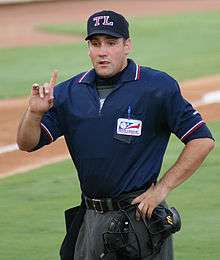
Throughout the season, all minor league umpires in Rookie leagues, Class-A, and Class-AA are evaluated by members of the MiLBUD staff.[23] All umpires receive a detailed written evaluation of their performance after every season.[23] In addition, all umpires (except those in the rookie or Short Season Class-A leagues) receive written mid-season evaluations.[23]
Generally, an umpire is regarded as making adequate progress "up the ranks" if he advances up one level of Class "A" ball each year (thus earning promotion to Class AA after three to four years) and promotion to Class AAA after two to three years on the Class AA level. However, this is a very rough estimate and other factors not discussed (such as the number of retirements at higher levels) may dramatically affect these estimates. For example, many umpires saw rapid advancement in 1999 due to the mass resignation of many Major League umpires as a collective bargaining ploy.
When promoted to the Class AAA level, an umpire's evaluation will also be conducted by the umpiring supervisory staff of Major League Baseball. In recent years, top AAA prospects, in addition to umpiring and being evaluated during the regular season (in either the International or Pacific Coast League), have been required to umpire in the Arizona Fall League where they receive extensive training and evaluation by Major League Baseball staff. Additionally, top minor league prospects will also be sent to umpire in winter leagues (during Major League and Minor League baseball's off-season) usually located in the Caribbean, Central America or South America.[24]
In addition, top AAA prospects may also be rewarded with umpiring only Major League preseason games during spring training (in lieu of Class AAA games). Additionally, the very top prospects may umpire Major League regular season games on a limited basis as "fill-in" umpires (where the Class AAA umpire replaces a sick, injured or vacationing Major League umpire).[25]
Finally, upon the retirement (or firing) of a Major League umpire, a top Class AAA umpire will be promoted to Major League Baseball's permanent umpire staff. During this entire process, if an umpire is evaluated as no longer being a major-league prospect, he will be released, ending his professional career. In all, MiLBUD estimates that it will take an umpire seven to eight years of professional umpiring before he will be considered for a major league position.[19]
As of 2018, major league umpires earn $150,000 to $450,000 per year depending on their experience, with a $340 per diem for hotel and meals.[26] Minor league umpires earn from $2,000 to $3,900 per month during the season.[26] Amounts vary based on the umpire's classification and experience.
As of March 2018, there are 19 four-man crews in MLB, for a total of 76 full-time umpires; they are augmented by 16 Class AAA umpires eligible to umpire regular season games, yielding a total roster of 92 MLB umpires.[27]
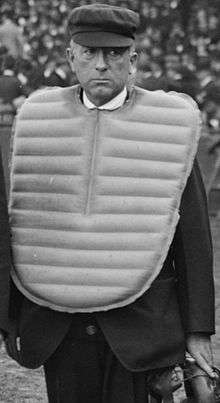
Uniform
Umpires are often referred as "Blue" because of the color of their uniforms. In the early days of baseball, umpire uniforms resembled suits (usually to keep them inconspicuous when in public) with the only difference being National League umpires wore an inside chest protector while American League umpires wore an outside (or "balloon") protector when calling balls and strikes.
In the 1960s, umpires were allowed to wear dress shirts that were light blue, and the American League umpires wore grey slacks with their blue coats, while National League umpires wore all blue coats and slacks. In 1970, the National League added a large patch on their coat and uniform with the league logo and a number on their left sleeve, along with a short-sleeved light blue shirt for hot summer games. The American League followed suit with the short sleeves in 1972, then in 1973 they wore a maroon blazer along with blue pants until 1979. In 1975, the American League umpire hats included the abbreviation "AL" (previous to that they included a shield for the AL). To celebrate the National League's 100th anniversary in 1976, the umpire blazers/light blue shirts included the league's centennial patch and the hats were designed in the "pillbox" style with the year "'76" included on them. In 1977, the use of the outside (balloon) protector was outlawed for new umpires but grandfathered for existing umpires, with the last umpire that used the outside protector, Jerry Neudecker, retiring in 1985. The use of ties with the blazers were gradually phased out; the last time they were worn in the World Series was in 1975 and overall was in the 1979 Major League Baseball All-Star Game by George Maloney, Terry Cooney, and Nick Bremigan. In World Series games starting in 1976, the umpires wore sweaters (light blue for National League umpires and off-white for American League umpires) instead of ties.
In 1980, Major League Baseball mandated that the umpires' uniforms be standardized, and they went to the American League pre-1973 style of blue blazers, grey slacks, and short sleeved light blue shirts; the American League began adding numbers to their umpire uniforms, with "AL" on their caps and National League umpires had "NL" on their caps. This style was pretty much the same (except for the use of windbreakers and sweaters later in the 1980s) through 1995. The league initials on the caps changed towards the late 1980s when the "N" and "L" were combined into a single letter, while the "A" and the "L" were interlocked.
In 1996, the button-down light blue shirt was replaced with a navy blue polo shirt with red and white trim on the collar and sleeve cuffs. The numbers were changed to red on the shirts, an "N" with the National League logo and an "A" with the American League logo on the hats. The American League used an optional red short-sleeved shirt (possibly a homage to the 1973-79 red blazers) that wasn't used by many umpires (the notable exceptions were Derryl Cousins and Dale Scott, who frequently wore the red shirts while working home plate, even as their colleagues on the bases wore navy blue shirts). The National League added a light blue shirt in 1997, which became much more popular than the red shirts in the AL.
Beginning in 2000, after the individual leagues' umpires were consolidated into a single staff, the 1996-99 uniform styles were carried over with "MLB" on the caps instead of the league designations. Since 2001, the uniforms switched to black blazers/windbreakers with grey slacks, with the hats now including the MLB logo (along with the short-sleeved light blue shirts), which remain relatively unchanged. The navy blue shirt was phased out in favor of black, and the light blue shirt was reintroduced after a brief experiment with gray. For the 2017 season, the umpires' jacket was black with light blue trim over the shoulders.
Famous umpires
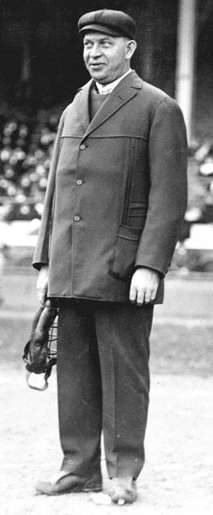
Hall of Fame
The following ten umpires have been inducted into the National Baseball Hall of Fame:[28]
- Class of 1953 – Tommy Connolly (NL, 1898–1900; AL, 1901–1931)
- Class of 1953 – Bill Klem (NL 1905–1941)
- Class of 1973 – Billy Evans (AL, 1906–1927)
- Class of 1974 – Jocko Conlan (NL 1941–1964)
- Class of 1976 – Cal Hubbard (AL, 1936–1951)
- Class of 1989 – Al Barlick (NL, 1940–1943, 1946–1955, 1958–1971)
- Class of 1992 – Bill McGowan (AL, 1925–1954)
- Class of 1999 – Nestor Chylak (AL, 1954–1978)
- Class of 2010 – Doug Harvey (NL 1962–1992)
- Class of 2013 – Hank O'Day (NL, 1895, 1897–1911, 1913, 1915–1927)
Conlan and O'Day played in 128 and 232 major league games, respectively, prior to becoming professional umpires.[29][30]
Several player inductees to the Hall of Fame served as substitute umpires for a small number of games during the early years of baseball; these include Hughie Jennings, Willie Keeler, King Kelly, and Chuck Klein.[31] Additionally, Hall of Fame player inductees Tim Keefe and Ed Walsh umpired professionally in the major leagues after their playing careers ended.[32][33]
Numbers retired by the National and American Leagues
Like players, umpires are identified by numbers on their uniforms. National League umpires began wearing numbers in 1970 (though they were assigned numbers in the 1960s) and American League umpires were assigned and began wearing uniform numbers in 1980. The National League umpires' numbers were initially assigned in alphabetical order (Al Barlick wearing number 1, Ken Burkhart number 2, etc.) from 1970 to 1978, which meant that an umpire's number could change each year depending on retirements and other staff changes. In 1979, the National League changed the numbering system and thereafter a number's umpire did not change from year to year. At first, as new umpires, they would be assigned higher numbers (for example, in 1979, Dave Pallone, Steve Fields, Fred Brocklander, and Lanny Harris were assigned numbers 26 to 29 instead of available numbers between 1 and 25). The National League numbering practice changed again in the mid-1980s, when new umpires were assigned previously used numbers (for example, in 1982 Gerry Davis was assigned number 12, previously worn by Andy Olsen, and in 1985 Tom Hallion was assigned number 20, previously worn by Ed Vargo.)
The American League's number assignments were largely random. Bill Haller, the senior American League umpire in 1980, wore number 1 until his retirement following the 1982 World Series, but the number was never reassigned.
In 2000, the American League and National League umpiring staffs were merged into a unified staff under the auspices of Major League Baseball, and all numbers were made available, including the numbers that had been retired by one of the leagues. (For example, the American League had retired Lou DiMuro's number 16 after his death, but it was made available to his son Mike after the staffs were unified.) In the event of duplications, the more senior umpire was given the first choice. (For example, Al Clark in the AL and Jerry Layne in the NL both wore the number 24, but because Clark had more seniority he was assigned 24 and Layne number 26. When Clark was relieved of his duties in 2000, Layne was able to obtain number 24.)
From time to time, Major League Baseball retires those numbers for umpires who have given outstanding service to the game, or in honor of umpires who have died.[34]
Since unified umpiring crews were established in 2000, all numbers are available to Major League Baseball umpires, as each retired number was reserved per league. Only one umpire number has been retired since the current format was established, 42, because of the Major League Baseball policy instituted in 1997.
- #1 Bill Klem (NL, 1905–41); currently worn by Bruce Dreckman
- #2 Nick Bremigan (AL, 1974–89); currently worn by Dan Bellino
- #2 Jocko Conlan (NL, 1941–64); worn by Jerry Crawford during his tenure in the NL (1977–1999)
- #3 Al Barlick (NL, 1940–43, 1946–55, 1958–71); currently worn by Bill Welke
- #9 Bill Kunkel (AL, 1968–84); also a National Basketball Association referee. Currently worn by Brian Gorman.
- #10 John McSherry (NL, 1971–1996); died at home plate during the Cincinnati Reds-Montreal Expos season opener. Currently worn by Phil Cuzzi.
- #16 Lou DiMuro (AL, 1963–82); killed in an auto-related accident after a game in Arlington, Texas.
- #42 Jackie Robinson (retired by Major League Baseball since April 15, 1997.) Worn by Fieldin Culbreth in the American League through 1999; Culbreth switched to #25 when a unified umpiring staff was first used in 2000.
Longest major league careers
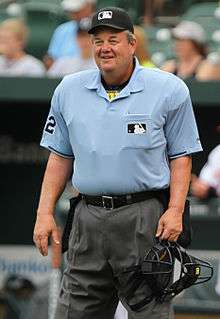
Most games
Regular season major league games umpired.
- 5,372 – Bill Klem[35]
- 5,310

- 5,163 – Bruce Froemming[37]
- 4,770 – Tommy Connolly[38]
- 4,673 – Doug Harvey[39]
![]()
Most seasons
Careers beginning prior to 1920:
- 37 – Bill Klem (NL, 1905–41)
- 35 – Bob Emslie (AA, 1890; NL, 1891–1924)
- 34 – Tommy Connolly (NL, 1898–1900; AL, 1901–31)
- 30 – Hank O'Day (NL, 1895, 1897–1911, 1913, 1915–27)
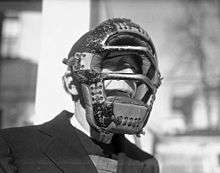
- 29 – Bill Dinneen (AL, 1909–37)
- 29 – Cy Rigler (NL, 1906–22, 1924–35)
- 25 – Brick Owens (NL, 1908, 1912–13; AL, 1916–37)
- 25 – Ernie Quigley (NL, 1913–37)
Careers beginning from 1920 to 1960:
- 30 – Bill McGowan (AL, 1925–54)
- 28 – Al Barlick (NL, 1940–43, 1946–55, 1958–71)
- 27 – Bill Summers (AL, 1933–59)
- 26 – Tom Gorman (NL, 1951–76)
- 25 – Nestor Chylak (AL, 1954–78)
- 25 – Jim Honochick (AL, 1949–73)
Careers beginning since 1960:
- 41 – Joe West (NL, 1976–99; MLB 2002–present), senior active Major League umpire as of 2019, and is recognized by MLB as having the longest tenure of any umpire in MLB history in terms of number of seasons umpired.[40]
- 37 – Bruce Froemming (NL, 1971–99; MLB, 2000–07), ejected New York Yankees manager Billy Martin from Game 4 of the 1976 World Series, made controversial ball four call which prevented Milt Pappas' perfect game in 1972
- 35 – Jerry Crawford (NL, 1976–99; MLB, 2000–2010), son of NL umpire Shag Crawford (1951–75) and brother of National Basketball Association official Joey Crawford (1977–2016)
- 35 – Joe Brinkman (AL, 1972–99; MLB, 2000–06) last active umpire to have used the balloon chest protector (Brinkman switched to the inside protector in 1980); former owner of umpire school; last active AL umpire to work prior to implementation of DH.
- 35 – Ed Montague (NL, 1974, 1976–99; MLB, 2000–09) One of three umpires (Bill Klem and Bill Summers were the others) to serve as World Series crew chief four times
- 35 – Gerry Davis (NL, 1982–1999, MLB 2000–present), owner of officials equipment store; has umpired more postseason games than any other umpire (134)
- 35 – Dana DeMuth (NL, 1985–99, MLB 2000–2019), made (with Jim Joyce) game-ending obstruction call in Game 3 of the 2013 World Series
- 34 – John Hirschbeck (AL, 1983–99, MLB 2000–2016), involved in infamous "spitting" incident with Roberto Alomar
- 34 – Derryl Cousins (AL 1979–99; MLB 2000–2012) last remaining replacement called up during the 1979 umpire strike and last AL umpire to have worn the red blazer (1973–79)
- 34 – Mike Reilly (AL, 1977–99, MLB 2000–2010)
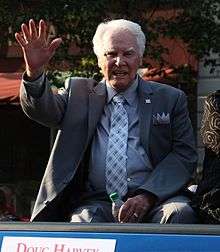
- 33 – Harry Wendelstedt (NL, 1966–98) The Wendelstedt family operates one of two MLB-approved umpire schools; son Hunter, currently an MLB umpire, took over after Harry's death in 2012.
- 33 – Tim McClelland (AL, 1983–99, MLB 2000–2013), home plate umpire in Pine Tar Game and home plate umpire for David Wells' perfect game in 1998
- 33 – Tim Welke (AL 1985–99, MLB 2000–2015), brother of umpire Bill Welke (1999–present), ejected Atlanta Braves manager Bobby Cox from Game 6 of the 1996 World Series
- 31 – Dave Phillips (AL, 1971–1999; MLB, 2000–2002) He was the crew chief during the 1979 Disco Demolition Night at Comiskey Park, ordering the Chicago White Sox to forfeit the second game of a scheduled doubleheader to the visiting Detroit Tigers. First umpire to throw Gaylord Perry out of a game for an illegal pitch (1982), threw out Albert Belle for a corked bat (1994)
- 31 – Larry Barnett (AL, 1968–99) Made "no interference" call in Game 3 of the 1975 World Series
- 31 – Doug Harvey (NL, 1962–92), home plate umpire in Game 1 of 1988 World Series, punctuated by dramatic pinch-hit home run by an injured Kirk Gibson
- 30 – Dale Scott (AL, 1987–1999, MLB 2000–2017); Last umpire to eject New York Yankees manager Billy Martin from a game, first openly homosexual umpire
- 30 - Jerry Layne (NL, 1989-1999, MLB 2000-present)
Others

Other noteworthy umpires have included:
- Emmett Ashford (AL, 1966–70), first African-American umpire in Major League Baseball; retired after working 1970 World Series, when he became the first African-American to officiate a championship series or game in a major North American professional sport
- Ted Barrett (MLB, 1999–present), first umpire to work home plate for two perfect games and worked home plate in Game 3 of the 2018 World Series, the longest game by time and innings in World Series history[41]
- Fred Brocklander (NL, 1979–92), replacement umpire called up during 1979 strike; called Game 6 of the 1986 National League Championship Series
- Jon Byrne (MLB 2014), the first Australian native to umpire a major league game in the modern era; Australian second baseman Joe Quinn was a substitute umpire for two National League games; one each in 1894 and 1896[42][43]
- Amanda Clement (SD, 1904–10), first paid female umpire
- Ramon De Jesus (MLB, 2016–present), first major league umpire from the Dominican Republic[44]
- Don Denkinger (AL, 1969–98), made infamous call in Game 6 of the 1985 World Series, then ejected St. Louis Cardinals manager Whitey Herzog and Cardinal pitcher Joaquín Andújar in Game 7
- Bill Dinneen (AL, 1909–37), called five no-hitters, and also pitched a no hitter (September 27, 1905); the only man to both pitch and call no-hit baseball games [45]
- Augie Donatelli (NL, 1950–73), made controversial "phantom tag" call in Game 2 of the 1973 World Series on the New York Mets' Bud Harrelson while sprawled on the ground at home plate in what was his final plate assignment
- Jim Evans (AL, 1971–99), ran one of only two official umpire schools until decertified after an incident in 2012
- Bernice Gera (NAPBL, 1972), first female umpire in professional baseball
- Bill Haller (AL, 1963–82), brother of Major League catcher Tom Haller; last umpire to use outside chest protector in World Series (Game 2 in 1982)
- Sam Holbrook (NL 1996-99, MLB 2000-present), made controversial Infield Fly Rule call in the 2012 National League Wild Card Playoff, ejected Washington Nationals manager Dave Martinez from Game 6 of the 2019 World Series, the most recent managerial ejection in World Series play
- Eddie Hurley (AL, 1947–65), home plate umpire when 3-foot-7 Eddie Gaedel came to bat for the St. Louis Browns on August 19, 1951, and walked on four pitches
- Jim Joyce (AL, 1987–99; MLB, 2000–2016), umpire whose incorrect call led to Armando Galarraga's near-perfect game
- Bill Kunkel (AL, 1968–84) former major league pitcher and National Basketball Association official; son Jeff was a major league infielder
- Ron Luciano (AL, 1969–80) All-American lineman for Syracuse University football team in late 1950s; later was an analyst for Major League Baseball on NBC and wrote four books
- John McSherry (NL, 1971–96) died of a heart attack after seven pitches of 1996 season opener between Expos and Reds
- Jerry Neudecker (AL, 1966–85) last AL umpire to use outside chest protector after league disallowed its use by new umpires starting in 1977
- Jake O'Donnell (AL, 1968–71) also a National Basketball Association official from 1967–95; only man to officiate both MLB and NBA all-star games

- Silk O'Loughlin (AL, 1902–18)
- Dave Pallone (NL, 1979–88) involved in 1988 shoving incident with then-Reds manager Pete Rose which led to Rose's 30-day suspension
- Steve Palermo (AL, 1977–91) career ended when he suffered spinal cord damage from a gunshot wound suffered on Dallas' Central Expressway while apprehending two armed robbers
- Babe Pinelli (NL, 1935–56) home plate umpire for Don Larsen's perfect game in Game 5 of the 1956 World Series
- Pam Postema first female umpire to work an MLB spring training game (1988), also worked the Hall of Fame Game in the same season
- Beans Reardon (NL, 1926–49) openly defied Bill Klem by using outside chest protector in NL
- Brian Runge (NL 1999, MLB 2000–12) first third-generation umpire following father Paul Runge (NL, 1974–97) and grandfather Ed Runge (AL, 1954–70)
- Jack Sheridan (PL, 1890; NL, 1892, 1896–97; AL, 1901–14)
- Art Williams (NL, 1972–77), first African-American umpire in the National League, worked the 1975 National League Championship Series
- Charlie Williams (NL, 1978–99, MLB 2000), in 1993, became first African-American umpire to work home plate in a World Series game
Current MLB umpiring crews
Below are the crews of umpires for the 2019 MLB season.[46] Crews frequently change over the course of the year as umpires are sometimes detached from their crew (so they do not work in their home city with some exceptions, such as the opening of a new stadium), are on vacation, or are injured. Each crew has an associated supervisor, usually a former MLB umpire, who is also listed.[47]
Etymology
According to the Middle English dictionary entry for noumpere, the predecessor of umpire came from the Old French nonper (from non, "not" and per, "equal"), meaning "one who is requested to act as arbiter of a dispute between two people", or that the arbiter is not paired with anyone in the dispute.[48]
In Middle English, the earliest form of this shows up as noumper around 1350, and the earliest version without the n shows up as owmpere, a variant spelling in Middle English, circa 1440.
The n was lost after it was written (in 1426–1427) as a noounpier with the a being the indefinite article. The leading n became attached to the article, changing it to an Oumper around 1475; this sort of linguistic shift is called false splitting. Thus today one says "an umpire" instead of "a numpire".
The word was applied to the officials of many sports other than baseball, including association football (where it has been superseded by referee) and cricket (which still uses it).
References
- "Official Rules: 9.00 The Umpire". MLB. Retrieved 2007-05-05.
- Haudricourt, Tom (2007-04-14). "Chief among game's umpires". Journal Sentinel. Archived from the original on 2007-09-29. Retrieved 2007-05-05.
- "Special Event selection". MLB. Retrieved 2007-05-05.
- "2007 MLB Umpire Crews". MLB. Archived from the original on 2007-01-25. Retrieved 2007-05-05.
- "Replay Review Regulations". MLB. MLB. Retrieved 20 April 2014.
- "MLB Umpires Missed 34,294 Ball-Strike Calls in 2018. Bring on Robo-umps?". BU Today. Retrieved 16 June 2019.
- "Umpire's Role". www.littleleague.org.
- "Umpires Home". Little League Baseball. Archived from the original on 2007-04-25. Retrieved 2007-05-05.
- "Participation Statistics". www.nfhs.org. Retrieved 2019-07-10.
- "Become an FHSAA Official - Baseball". www.becomeanofficial.org. Retrieved 2019-07-10.
- "About". www.jaxump.com. Retrieved 2019-07-10.
- "GHSA Contest Officials Handbook and Accountability Program | GHSA.net". www.ghsa.net. Retrieved 2019-07-10.
- "AboutUs". www.nfhs.org. Retrieved 2019-07-10.
- "National Federation of State High School Associations - 2019 Baseball Rules Book". www.nfhs.com. Retrieved 2019-07-10.
- "OBR-FED rule differences - UmpireBible". www.umpirebible.com. Retrieved 2019-07-10.
- , retrieved November 1, 2013
- "Where are the Professional Umpire Schools Located?". MiLB. Retrieved 2007-05-05.
- "MLB Umpire Camps". Major League Baseball.
- "Become an Umpire - MiLB.com Official Info - The Official Site of Minor League Baseball". MiLB.com.
- "Minor League Baseball umpires". MiLB.com. Retrieved 2019-07-11.
- "Coastal Plain League". Coastal Plain League. Retrieved 2019-07-11.
- "Coastal Plain League". Coastal Plain League. Retrieved 2019-07-11.
- "Umpires - MiLB.com Official Info - The Official Site of Minor League Baseball". MiLB.com.
- Imber, Gil. "2016-17 Winter League MiLB Umpire Rosters". Retrieved 2019-07-11.
- Imber, Gil. "Triple-A Call-Up and Fill-In Results - 2018-19 Offseason". Retrieved 2019-07-11.
- Miller, Kerry (May 3, 2018). "How Much Are MLB Umpires Paid?". Bleacher Report. Retrieved September 1, 2018.
- "Major League Umpire Roster". MLB.com. March 2018. Retrieved September 1, 2018.
- "Hall of Fame Umpires". Baseball Almanac. Retrieved August 21, 2017.
- "Jocko Conlan". Retrosheet.org. Retrieved August 28, 2017.
- "Hank O'Day". Retrosheet.org. Retrieved August 28, 2017.
- "The Directory of Umpires". Retrosheet.org. Retrieved August 28, 2017.
- "Tim Keefe". Retrosheet.org. Retrieved August 28, 2017.
- "Ed Walsh". Retrosheet.org. Retrieved August 28, 2017.
- "Umpires: Feature". Major League Baseball.
- "Bill Klem". Retrosheet.org. Retrieved August 28, 2017.
- "Joe West". Retrosheet.org. Retrieved November 21, 2018.
- "Bruce Froemming". Retrosheet.org. Retrieved August 28, 2017.
- "Tommy Connolly". Retrosheet.org. Retrieved August 28, 2017.
- "Doug Harvey". Retrosheet.org. Retrieved August 28, 2017.
- "Joe West becomes longest-tenured umpire - closecallsports.com". closecallsports.com.
- Imber, Gil (June 13, 2012). "Record Breaker: Another Perfecto, Umpiring History Made". Close Call Sports.
- "Joe Quinn Stats". Baseball Almanac. Retrieved August 28, 2017.
- "Joe Quinn". Retrosheet.org. Retrieved August 28, 2017.
- Adler, David (April 22, 2016). "De Jesus debuts as first MLB umpire from DR". MLB.com. Retrieved August 21, 2017.
- "Umpires: Feature". Major League Baseball.
- "2019 MLB Umpire Crews". Close Call Sports. February 25, 2019. Retrieved February 25, 2019.
- "Umpire Executives". MLB.com. Retrieved September 1, 2018.
- "'Umpire' Came from French as Word Meaning `Not Equal'". Deseret News. Salt Lake City. Merriam-Webster. October 13, 1996. Retrieved September 2, 2018.
Further reading
- Gorman, Tom (1979). Three and Two! The Autobiography of Tom Gorman, the Great Major League Umpire. as told to Jerome Holtzman. Scribner. ISBN 0684161699.
- Harvey, Doug (2014). They Called Me God: The Best Umpire Who Ever Lived. Gallery Books. ISBN 1476748780.
- Johnson, Harry (2005). Standing the Gaff: The Life and Hard Times of a Minor League Umpire (2nd ed.). University of Alabama Press. ISBN 978-0817352745.
- Kaiser, Ken; Fisher, David (2003). Planet of the Umps: A Baseball Life from Behind the Plate. Thomas Dunne Books. ISBN 0312304161.
- Luciano, Ron (1982). The Umpire Strikes Back. Bantam Dell Pub Group. ISBN 0553050109.
- Merrill, Durwood (1998). You're Out and You're Ugly, Too!: Confessions Of An Umpire With An Attitude. with Jim Dent. St. Martin's Press. ISBN 0312182376.
- Motley, Bob (2012). Ruling Over Monarchs, Giants & Stars: Umpiring in the Negro Leagues & Beyond. with Byron Motley, foreword by Dionne Warwick. Sports Publishing. ISBN 1613210590.
First-hand account of umpiring in the dying days of Negro league ball.
- Phillips, Dave (2004). Center Field on Fire: An Umpire's Life with Pine tar Bats, Spitballs, and Corked Personalities. with Rob Rains, foreword by Bob Costas. Triumph Books. ISBN 1572435690.
- Skipper, John C. (1997). Umpires: Classic Baseball Stories from the Men Who Made the Calls. McFarland & Company. ISBN 0786403640.
External links
| Wikimedia Commons has media related to Baseball umpires. |
- Umpires at Baseball Almanac
- Umpire at Baseball-Reference.com
- MLB Umpires. Major League Baseball
- World Umpires Association (labor union for major-league umpires)
- Association of Minor League Umpires
- Umpire's Role. Little League Baseball & Softball
